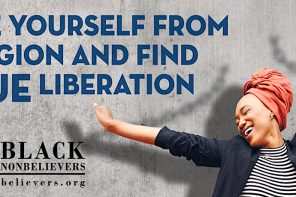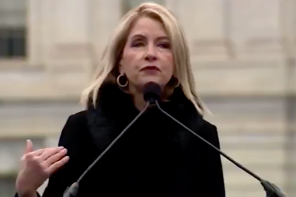A month after Barack Obama’s presidential win, I found myself at a table with progressive Christian leaders; including figures from Obama’s religious outreach and transition teams, as well as some of the East Coast’s most important theologians, seminary presidents, and faith consultants. Our task: To determine how religion could continue to best serve progressive politics.
I was thrilled to join this conversation. But by its end I couldn’t shake the feeling that despite Obama’s victory, progressive religion had played into the hands of the religious right and furthered the fundamentalist takeover of our political process. I remember exactly when it happened. Someone asked the following question: “We’ve been talking about progressive religion for hours, but what about being progressive about religion? They’re not the same thing.”
I’ve come to believe that progressive religion isn’t good enough for our nation. Instead, we need a shift in paradigm. We need to become progressive about religion. But what does that mean? It doesn’t mean atheism or secularization. It doesn’t mean progressive Christianity or progressive religion of any one tradition. None of these options are progressive enough.
In these reflections, I want to think differently. My comments, I admit, speak of a reality that doesn’t yet exist. They’re expressions of desire, of how I’d like us to imagine the future of religion in the United States and abroad. Here’s my argument in a nutshell: Being progressive about religion means moving from a multi-religious nation toward a nation of multi-religious individuals. Let me explain.
Our Religious Situation
The United States lives two religious realities: In our makeup as a people, we’re at the forefront of religious development. But we’re at the tail end when it comes to how our politics handles religion.
We’re at the forefront because we’re the most religious people among the rich industrial nations. We’re also the world’s most religiously diverse nation, with a dizzying array of Christianities, more Muslims than Episcopalians or Presbyterians, more Jews than Israel, and thriving communities of Buddhists, Hindus, Sikhs, Wiccans, Santeros, and others. And befitting a nation where 27 percent of the population says “I do” to religiously-mixed marriages, we’ve elected the first president that embodies the diversity of our make-up. The United States enjoys a level of religious effervescence second to none.
We’re at the tail end, however, because our religious diversity vanishes when it comes in contact with our political culture and process. We’ve become a country that actually requires its politicians to take openly Christian positions if they are to be successful, a country that sets up what I call “Christian litmus tests” for candidates running for office, a country that is unwilling to accept an agnostic, atheist, or non-Christian president. As David Domke and Kevin Coe write in their book The God Strategy: How Religion Became a Political Weapon in America, “politicians need not always walk the religious walk, but they had better be able to talk the religious talk.” And that talk is Christian.
We need to find, in the chasm between our makeup and our politics, a different way to think about religion, as well as a different way of being religious—for us and for the world.
Obstacles: Progressive Christianity and New Atheism
The Christian Right is an obvious obstacle to the emergence of a new way of thinking about religion and being religious. Less obvious is the fact that both progressive Christianity and the new atheism are obstacles as well. They too contribute to the ruling fundamentalism.
How? The Christian right develops religious arguments against gay rights, reproductive rights, social security, and other topics. In response, progressive Christians develop opposing religious arguments. The end result is to make our political culture even more religious, and to legitimize a preeminent role for argument from Christian principles. Now both the Republican and the Democratic Parties stress religion; now both the right and the left speak in Christian terms.
Atheism is no help either. In a world that’s becoming more religious rather than less, atheism can’t be the answer. Advocates of atheism remain tied to the discredited secularization thesis, making them a minority condemned to insignificance except within circles ever more out of touch with global reality. In addition, their strident tone feeds the culture wars and strengthens the right’s belief that Christianity is under siege.
Being progressive about religion requires rescuing the best of atheism and progressive Christianity while discarding their mistakes. From atheists, I’d rescue the commitment to reason. Like them, I’m unwilling to abdicate the use of my rational capacity in the name of faith. Unlike atheists, however, I don’t believe religions are false. Billions of people practice religions; in that sense they’re true. Billions of people believe in God; in that sense God does exist. Religions are true, but they’re not sacred. We need to be as self-reflective and critical of religion as we are of any other part of life.
From progressive Christians, I’d rescue the commitment to progressive understandings of faith and politics. But I’d reject their reliance on the Bible and Jesus. Here they are no different from the religious right, picking and choosing what suits them while ignoring what doesn’t.
Instead: Multi-Religiosity
In a time when religions have literally set the world on fire, we can’t settle for a more progressive Christianity or atheism as the alternatives to fundamentalism. Neither does justice to the United States’ status as the world’s most influential nation. Instead, being progressive about religion should mean taking the logic of religious diversity to its ultimate conclusion and fostering the conditions to create multi-religious individuals.
What’s involved? The United States is currently a multi-religious nation, and a nation that individuals of a variety of religions peacefully co-exist within. But we’re rarely multi-religious individuals: individuals who belong to more than one religion. We still think of religions as closed worlds, sovereign states zealously guarding their territorial boundaries. People aren’t allowed to belong to more than one religion or to borrow the ideas and practices of another without feeling like they’re traitors to their faith.
But religions need not be viewed as mutually exclusive and monolithic structures. Instead, they can be resources to tinker with and borrow from. We’re usually born into a religion, but as human beings all of them are our inheritance. To embrace this view is to become a multi-religious individual, someone who draws from more than one religious tradition to forge a spiritual path. This understanding of religion has scholarly basis. The boundaries between religions were often the creation of specific political interests. They have a time and place of birth. They’re not always as natural and obvious as we’ve come to believe.
Moreover, if everyone from the right to the left of the religious-political spectrum is picking and choosing some parts of Christianity while ignoring and rejecting others, why stay within one religion in the process? If the Bible is so suspect that large parts of it need to be ignored, why not open the process to picking from many religions as well? “What religions do you recommend?” or “what parts of a religion do you recommend?” sound like strange questions. But if we imagine the ability to pick and choose from different religions, then it’s a question future generations will be asking. To practice more than one religion (or better yet, to build a religious life with elements from different religions) is to tear down the walls between faiths that makes fundamentalism possible.
We already have some of the necessary requirements: an immense curiosity for all things religious, a diverse religious population that often enters into interreligious marriage, a growing percentage of people who change faiths, a growing number of people in the “spiritual but not religious” category (and so find themselves outside of traditional institutional boundaries); and we’re part of a process of globalization that shrinks distances and blurs boundaries, bringing even the most foreign of practices to our TV screens and shores.
But if people are going to pick and choose elements of different religions, they need to be given the tools to be able to do so. Stephen Prothero, in his Religious Literacy: What Every American needs to Know—and Doesn’t warned of our widespread ignorance of the world’s religions. We need to ask ourselves what it would take to become the most religiously literate nation on earth. We need to ask ourselves what kind of education in religion makes multi-religiosity possible and what kind of understanding of the separation of church and state provides its best framework.
In God is Back: How the Global Revival of Faith will Change the World, John Micklethwait and Adrian Wooldridge open their book with a Bible study scene that one assumes is set in a part of the country known for its megachurches (Glendale, Arizona, perhaps; or Louisville, Kentucky); except its Shanghai. The ability to shape ways of thinking beyond our own borders is called “soft power” in foreign policy circles, and provides a vivid example of why what we do with religion on our soil is so important. What if we could develop an approach to religion that involved delving into them all?




